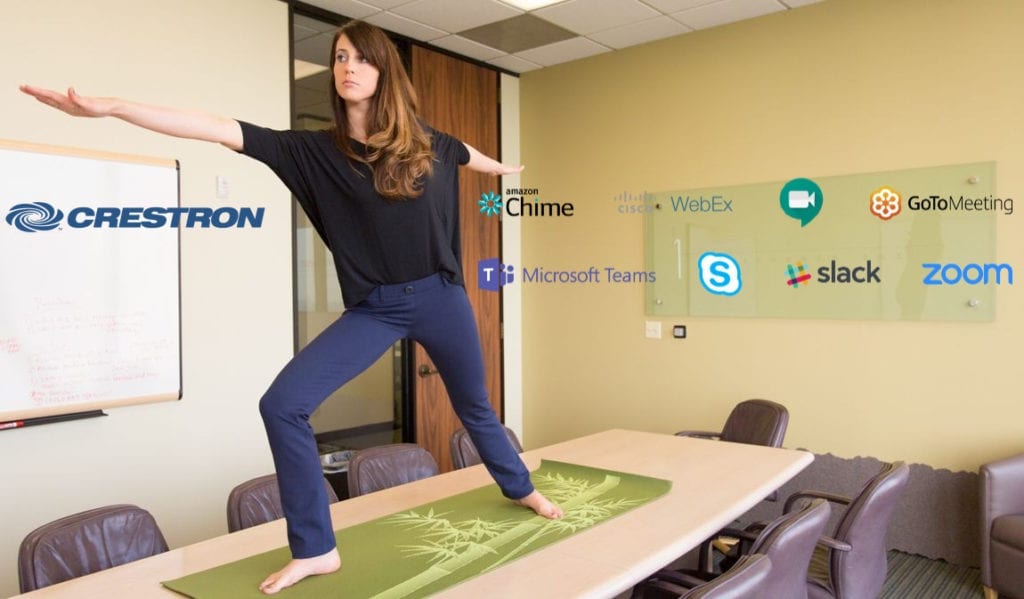There are now so many choices for office communication, it can become overwhelming (Slack, Teams, 8×8, Zoom, Google Meet, Cisco Webex, RingCentral, etc). Many companies were forced to choose quickly in 2020, as lock-downs and office closures became a reality. As a result, a few of these solutions became a verb and part of our daily lives.
As work continues to happen with a remote & blended workforce, maximum flexibility in the conference room is important for several reasons.
Employees Prefer Conferencing Options
For the same reason Bring Your Own Device (BYOD) has become popular in all types of organizations from small businesses to enterprise, giving options to employees is popular.
Whether you conduct a formal employee survey every year or simply walk around the conference room, chances are your employees prefer different video conferencing systems. Some may have long been a user of Google Meet, or utilize Zoom to connect with family.
Preferences can also occur based on device and department. Apple’s MacBook may be popular with executives, designers, and marketing departments. While Microsoft is often a preference of accounting, finance and IT departments.
Computer preferences can influence video conferencing solutions. While Microsoft Teams works well on all devices, more features are available for Office365, Outlook and Windows users including better syncing, collaboration and offline mode. In a similar way, users of Gmail or Google Apps can unlock more features in Google Meet.
For all of the above reasons, employees prefer different video conferencing systems depending on personal use, computer device and role/function. While security is a concern, communication and employee productivity can be improved with choice!
Flexible Video Conferencing Can Save Money
While it sounds counterintuitive, providing more choices can actually save businesses money. In the same way VoIP upended costly phone service plans by providing more competition, video conferencing options exploded in 2020.
The pandemic transformed challengers into leaders and revealed differentiation between platforms according to the latest Gartner Magic Quadrant for Meeting Solutions. Enterprise organizations adopted Microsoft Teams and 8X8 for security and video encryption.
Longtime leaders such as LogMeIn’s GoToMeeting and Cisco’s Webex continued to expand integrations and features for paid subscriptions. While Google rebranded from Hangouts to Meet and expanded meeting time limits and users.
At the same time, new video conferencing options from RingCentral, SignalWire and other players entered the crowded marketplace. Salesforce bought out Slack, indicating it could soon launch meeting and voice capabilities. Meanwhile, Zoom added a phone and looks to expand communication features.
The end result is a variety of disruption to unified communications that should continue for the next several years. As public companies including Zoom, RingCentral and 8X8 chase growth, expect more incentives for companies to switch platforms.
Having a conference room that can adapt to changing technologies can save money in the short and long term. For 2021, look into some of the new communication software options available and switch providers for savings and better features.
Better Customer Experience
For B2B organizations there is another user of video conferencing and communication software besides employees, the end customer! And the customer is always right.
Chances are your sales and customer service teams already make accommodations. Customers often prefer their own video conferencing platform. It might not even be a choice, but a requirement from IT for security. So, while your company spent money installing Zoom Rooms, you’re now forced to communicate with some clients on Microsoft Teams.
Avoid the problem altogether by designing a conference room that integrates with everyone. As an Elite Partner and Dealer of Crestron, c2mtech installs Crestron Flex which is compatible with Microsoft Teams Rooms, Zoom Rooms and BYOD.


